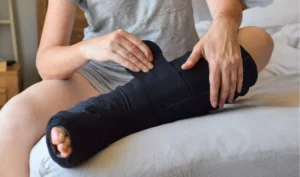Advances in Lymphedema: Recent Developments in the Treatment of Breast Cancer-Related Lymphedema
The management of lymphedema, especially breast cancer-related lymphedema, has seen significant advances in recent years. This condition, which can arise as a secondary effect of breast cancer treatment, leads to swelling in the limbs due to lymphatic fluid accumulation. With the growing body of research and innovations in treatment options, patients with lymphedema can experience improved quality of life and better management strategies. This article delves into recent developments in the treatment of lymphedema, specifically focusing on breast cancer-related lymphedema, its causes, treatment options, and self-management strategies.
What are the Latest Advances in the Treatment of Lymphedema?
Overview of Recent Research in Lymphedema Treatment
Recent research into the treatment of lymphedema has highlighted the need for a multifaceted approach tailored to individual patients. Studies have shown that approximately 20-30% of breast cancer patients develop secondary lymphedema following breast cancer surgery and radiation therapy. Advances in our understanding of the pathophysiology of lymphedema have driven the development of novel treatment modalities, which focus on both prevention and management. Researchers are investigating the efficacy of lymph node transfer for treatment, which has shown promise in reducing arm lymphedema in breast cancer survivors. Additionally, new insights into the role of inflammation in lymphedema development have spurred interest in anti-inflammatory medications as potential therapies.
Innovative Treatment Options for Patients with Lymphedema
Innovative treatment options for patients with lymphedema have emerged, encompassing both surgical and non-surgical approaches. Among the most notable advances is the adoption of lymphaticovenous anastomosis (LVA), a surgical treatment that connects lymphatic vessels directly to the venous system, effectively bypassing the blocked areas and alleviating swelling. Moreover, the utilization of compression therapy has evolved, with advancements in fabric technology leading to more comfortable and effective compression garments for patients with upper and lower extremity lymphedema. The introduction of digital health technologies, such as mobile applications for self-monitoring and education, further empowers patients to manage their condition actively.
Future Directions in Lymphedema Management
Looking ahead, the future directions in lymphedema management are promising. Ongoing clinical trials are exploring the long-term effects of various surgical treatments, including lymph node transfer, in reducing the incidence and severity of lymphedema in breast cancer patients. Research into gene therapy and regenerative medicine also presents exciting possibilities for treating primary lymphedema and secondary lymphedema resulting from breast cancer treatment. As the prevalence of lymphedema becomes more recognized in the oncology community, there is a growing emphasis on early detection and intervention strategies, which could drastically improve outcomes for patients with lymphedema.
How Does Breast Cancer Affect Lymphedema Development?
Understanding the Pathophysiology of Lymphedema in Breast Cancer Patients
The pathophysiology of lymphedema in breast cancer patients is complex and involves the disruption of normal lymphatic drainage, primarily due to surgical interventions such as mastectomies and axillary lymph node dissections. This disruption leads to lymphatic fluid accumulation, which causes swelling in the affected limb. The inflammatory process triggered by surgery and radiation therapy can further exacerbate lymphatic dysfunction, leading to a heightened risk of developing secondary arm lymphedema. Understanding these mechanisms is crucial for developing effective treatment and management protocols for patients with breast cancer-related lymphedema.
Secondary Lymphedema: Causes and Consequences in Breast Cancer
Secondary lymphedema following breast cancer treatment is a significant concern for many patients. The causes of this condition can be attributed to various factors, including surgical trauma, radiation damage to lymphatic tissues, and the removal of lymph nodes. The consequences of secondary lymphedema extend beyond physical symptoms; they can significantly affect psychological well-being and the overall quality of life for breast cancer survivors. Patients often report feelings of frustration, anxiety, and isolation due to the visible changes in their bodies and the limitations imposed by lymphedema. Addressing these psychological aspects is essential in providing comprehensive care for patients with lymphedema.
Impact of Lymphedema on Quality of Life for Breast Cancer Survivors
The impact of lymphedema on the quality of life for breast cancer survivors cannot be overstated. Studies have indicated that patients with lymphedema experience difficulties in performing daily activities, increased discomfort, and limited mobility. The physical manifestations of upper extremity lymphedema, such as swelling and heaviness in the arm, can lead to decreased participation in social activities and a decline in mental health. Consequently, it is vital for healthcare providers to recognize the multifaceted challenges posed by lymphedema and to implement individualized treatment plans that address not just the physical symptoms but also the emotional and social factors affecting patients.
What are the Surgical Treatment Options for Lymphedema?
Types of Surgical Treatments for Lymphedema
Surgical treatment options for lymphedema have become increasingly sophisticated, offering hope to patients who may not respond adequately to conservative management strategies. Various surgical techniques are employed, including lymph node transfer, liposuction for lymphedema, and LVA. Lymph node transfer involves relocating healthy lymph nodes to areas where lymphatic flow is compromised, effectively restoring drainage and reducing swelling. Liposuction, on the other hand, is utilized in cases of chronic lymphedema to remove excess fatty tissue that has accumulated due to lymphatic obstruction. Each surgical option presents unique benefits and is chosen based on the patient’s specific condition and needs.
Benefits and Risks of Surgical Intervention
The benefits of surgical intervention for lymphedema can be substantial, often resulting in significant reductions in limb volume and improvements in quality of life. However, it is crucial to consider the associated risks, which may include complications such as infection, seroma formation, and incomplete resolution of lymphedema symptoms. Patients must engage in thorough discussions with their healthcare providers to weigh the potential advantages against these risks, ensuring informed decision-making regarding their treatment options.
Criteria for Surgical Treatment in Breast Cancer-Related Lymphedema
Criteria for surgical treatment of breast cancer-related lymphedema typically include the severity of lymphedema, the duration since onset, and the patient’s overall health status. Generally, patients who have failed conservative management strategies such as compression therapy or physical therapy are considered candidates for surgical intervention. Additionally, patients with significant functional impairment or psychosocial distress due to lymphedema may benefit from surgical options to enhance their quality of life. A comprehensive assessment by a multidisciplinary team is essential in determining the appropriateness of surgical treatment for each individual.
What Non-Surgical Treatment Options are Available for Lymphedema Management?
Compression Therapy as a Primary Treatment for Lymphedema
Compression therapy remains one of the most effective non-surgical treatment options for managing lymphedema. This approach involves the use of specially designed garments and bandages to apply pressure to the affected limbs, promoting lymphatic drainage and minimizing swelling. For patients with arm lymphedema or lower extremity lymphedema, compression garments can significantly reduce limb volume and discomfort. Ongoing advancements in compression technology, including adjustable and breathable materials, have made this treatment more accessible and comfortable for patients, enhancing adherence and overall outcomes.
Physical Therapy Techniques for Managing Lymphedema
Physical therapy techniques play a vital role in the management of lymphedema. Manual lymph drainage (MLD), a specialized form of massage therapy, helps stimulate lymphatic flow and reduce swelling. Additionally, exercise programs tailored for lymphedema patients can enhance mobility, strengthen muscles, and promote lymphatic drainage. Educating patients about proper skin care and hygiene is also integral to physical therapy, as skin integrity is crucial in preventing infections in lymphedematous limbs. By incorporating physical therapy into a comprehensive management plan, patients can achieve better outcomes and improved quality of life.
Medication and Alternative Therapies for Lymphedema Patients
In addition to conventional therapies, medications and alternative therapies can complement the treatment of lymphedema. Some patients may benefit from anti-inflammatory medications to manage swelling and discomfort, while others explore alternative therapies such as acupuncture and herbal remedies. Although the scientific evidence for the efficacy of these alternative approaches varies, many patients report subjective improvements in their symptoms and overall well-being. It is essential for patients to discuss any alternative therapy with their healthcare providers to ensure safe and appropriate integration into their treatment regimens.
How Can Patients with Lymphedema Best Manage Their Condition?
Self-Care Strategies for Patients with Arm and Lower Extremity Lymphedema
Self-care strategies are crucial for patients with lymphedema to effectively manage their condition. Patients are encouraged to engage in regular exercise tailored to their abilities, as physical activity can enhance lymphatic flow and reduce swelling. Additionally, maintaining a healthy diet and staying hydrated can support overall lymphatic function. Patients with arm lymphedema should practice good skin care, avoiding cuts and injuries that could lead to infections. Education on proper techniques for donning and doffing compression garments is also vital, as correct usage can maximize the benefits of compression therapy.
Monitoring and Recognizing Symptoms of Lymphedema Progression
Monitoring and recognizing symptoms of lymphedema progression is essential for timely intervention. Patients should be vigilant about changes in limb size, texture, or sensation, as these may indicate worsening lymphedema. Regular self-assessments and follow-up appointments with healthcare providers can help identify any changes early, allowing for adjustments in treatment strategies. Utilizing tools such as a lymphedema tracking app can also aid patients in maintaining records of their symptoms and treatment adherence, fostering proactive management of their condition.
Support Systems: Resources for Patients Living with Lymphedema
Support systems and resources are invaluable for patients living with lymphedema. Connecting with support groups, either in-person or online, can provide emotional support and practical advice from others who share similar experiences. Educational resources such as workshops, webinars, and informational pamphlets can empower patients with knowledge about their condition and treatment options. Engaging with healthcare professionals who specialize in lymphedema management is also crucial, as they can offer tailored guidance and support throughout the patient’s journey. By fostering a robust support network, patients can navigate the challenges of lymphedema more effectively and enhance their overall well-being.
FAQS
Q: What is the incidence of lymphedema in patients with breast cancer?
A: The incidence of lymphedema in patients with breast cancer can vary, but studies suggest that up to 30% of women with breast cancer may develop breast cancer-related lymphedema following surgery or radiation treatment.
Q: What are the stages of lymphedema?
A: Lymphedema is generally classified into four stages: Stage 0 (latent), where no visible swelling occurs; Stage 1 (reversible), where swelling may fluctuate; Stage 2 (spontaneously irreversible), where swelling is more persistent; and Stage 3 (lymphostatic elephantiasis), characterized by significant swelling and changes in skin texture.
Q: How can patients prevent lymphedema after breast cancer treatment?
A: To prevent lymphedema after breast cancer treatment, patients can engage in exercises that promote lymphatic drainage, maintain a healthy weight, avoid tight clothing, and protect the affected area from injury or infection.
Q: What are the most common treatments for upper limb lymphedema?
A: The management of lymphedema typically includes therapies such as manual lymphatic drainage, compression garments, exercise, and skin care. In some cases, surgical treatment of lymphedema may be considered.
Q: What is postmastectomy lymphedema, and how does it develop?
A: Postmastectomy lymphedema is a form of lymphedema that can occur in patients after breast cancer surgery, particularly if lymph nodes are removed or damaged. This condition can develop due to the disruption of normal lymphatic flow.
Q: What is the treatment of secondary lymphedema associated with breast cancer?
A: The treatment of secondary lymphedema associated with breast cancer may involve a combination of physical therapy, compression therapy, and skincare. In severe cases, surgical options may be explored to improve lymphatic drainage.
Q: How does lymphedema affect patients with lower extremity lymphedema?
A: Lymphedema in patients with lower extremity lymphedema can lead to swelling, discomfort, and limited mobility. It is essential for these patients to engage in appropriate management strategies to alleviate symptoms and prevent complications.
Q: What are the findings of lymphedema in women with breast cancer?
A: Findings of lymphedema in women with breast cancer typically include swelling in the arm or chest area, a feeling of heaviness, and potential skin changes. Early diagnosis and treatment are crucial for effective management.
Q: What is the role of exercise in the management of lymphedema?
A: Exercise plays a significant role in the management of lymphedema as it helps to improve lymphatic flow, reduce swelling, and enhance overall well-being. Tailored exercise programs can be beneficial for patients with breast cancer-related lymphedema.





